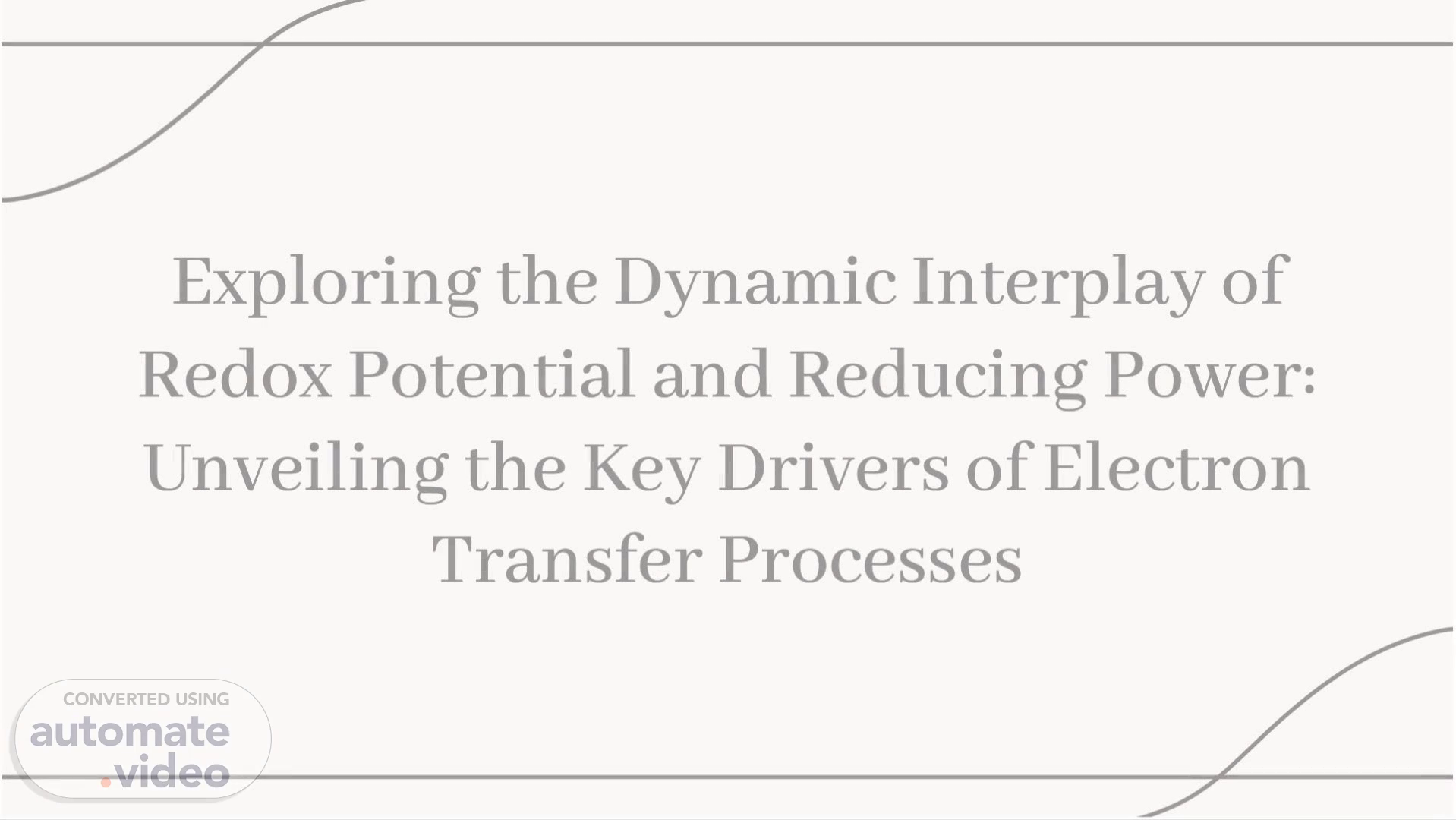
Arpita -202311210511511H8t (1)
Scene 1 (0s)
[Audio] In this research, we examine the relationship between redox potential and reducing power in order to uncover the key drivers of electron transfer processes. By looking at the dynamic interplay between the two, we can gain an understanding of how this process affects our daily lives and potential new ways to make use of this energy. We have investigated the dynamic interplay between redox potential and reducing power to uncover the key drivers of electron transfer processes. Our findings provide insight into how these processes affect our daily lives and can help us identify potential new opportunities to make use of this energy..
Scene 2 (41s)
[Audio] We will examine the relationship between redox potential and reducing power in regards to electron transfer processes. Redox potential and reducing power are essential components that facilitate electron transfer and by understanding their relationship, we can gain a better understanding of how biological and chemical systems operate. We will dive into the key drivers that influence these interactions and their implications on our lives..
Scene 3 (1m 8s)
[Audio] Redox potential, or oxidation-reduction potential, is the measure of the activities of oxidizing and reducing agents and their tendency to either accept or donate electrons. This difference in activities drives electron transfer reactions and is an essential concept in understanding electron transfer processes. A further concept is that of reducing power, which is the ability of a reactant to accept electrons and reduce other compounds. Reducing power plays a major role in electron transfer processes and has a major influence on the rate of electron transfer. Understanding the interaction of redox potential and reducing power provides us with the necessary insight into the fundamentals of electron transfer mechanisms..
Scene 4 (1m 54s)
[Audio] In this slide we will discuss the relationship between redox potential and reducing power and how they can be used to understand electron transfer processes. Redox potential is a measure of the relative tendency of a chemical species to donate or receive electrons. Reducing power is a measure of the capacity of an oxidizing agent to donate electrons or accept protons. By studying the relationship between redox potential and reducing power, we can gain insight into how both of these factors influence electron transfer processes." In this slide we will discuss the relationship between redox potential and reducing power. Redox potential is a measure of the relative tendency of a chemical species to transfer electrons, while reducing power measures the capacity of an oxidizing agent to donate or accept protons. By studying the interaction between redox potential and reducing power, we can gain important insights into electron transfer processes and how they are influenced by these two factors..
Scene 5 (2m 57s)
[Audio] Redox potential and reducing power are critical for electron transfer processes that power life. Redox potential is the capacity of a molecule to readily give up electrons and reducing power is the capacity of a molecule to be oxidized. This exploration will look at the ramifications of redox potential and reducing power on the mechanisms of cellular operation. There is a direct association between redox potential and reducing power and how they affect cellular activity. We will also look at how recognizing these two components can be useful in comprehending the mechanisms of electron transfer..
Scene 6 (3m 36s)
[Audio] Redox potential and reducing power are essential for a variety of chemical processes. For instance, they are employed in catalysis to facilitate electron transfer reactions. In electrochemistry, redox potential is used to generate efficient electrical energy. Furthermore, it can be used to understand the transformation of chemical compounds and their reactivity. Exploring the applications of redox potential and reducing power in chemistry is the focus of this slide. We can gain insight into the mechanisms behind these transformation processes by understanding the relationship between redox potential and reducing power..
Scene 7 (4m 19s)
[Audio] We will be exploring the relationship between redox potential and reducing power to uncover the key drivers of electron transfer processes. Redox potential describes the tendency of a chemical species to donate or accept electrons and reducing power measures the capability of a species to transfer electrons. Investigating the mechanisms underlying electron transfer can reveal how these two forces interact. This slide will discuss the pathways and factors that influence electron transfer processes. Let's begin!.
Scene 8 (4m 54s)
[Audio] With respect to redox potential and reducing power, this discussion will explore the various methods of measuring and analyzing them. We will analyze the benefits and drawbacks of established methods, as well as assessing recent developments in the field. Examining a range of techniques can provide a deeper insight into the fundamental mechanisms of electron transfer..
Scene 9 (5m 18s)
[Audio] We discussed the intricate relationship between redox potential and reducing power and explored how they interact to drive electron transfer processes across biological and chemical systems. Understanding these dynamic interactions is essential for broadening our knowledge in various scientific and technological fields. This presentation has provided us with valuable insights into these processes and, in turn, how to use them to our advantage. I hope this has been an informative and enriching experience for you all. Thank you for your attention..